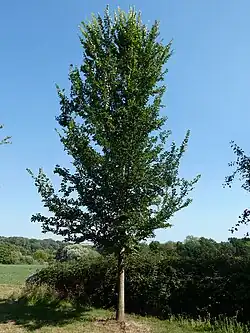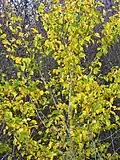Ulmus × hollandica 'Ademuz'
| Ulmus × hollandica 'Ademuz' | |
|---|---|
 Ulmus × hollandica 'Ademuz' | |
| Genus | Ulmus |
| Hybrid parentage | U. minor × U. glabra |
| Cultivar | 'Ademuz' |
| Origin | Spain |
The elm cultivar Ulmus × hollandica 'Ademuz' was cloned by root cuttings from an ancient tree discovered in 1996 by Margarita Burón of the Escuela Técnica Superior de Ingenieros de Montes, Universidad Politėcnica de Madrid (UPM). 'Ademuz' has a very high tolerance of Dutch elm disease. In the Madrid study, the appearance of the tree was rated 4.5 / 5, the most attractive of seven cultivars under assessment.[1]
'Ademuz' was introduced to the UK in 2014 by Hampshire & Isle of Wight Branch, Butterfly Conservation as part of an assessment of DED-resistant cultivars as potential hosts of the endangered White-letter Hairstreak.[2] 'Ademuz' was observed hosting the White-letter Hairstreak in Hampshire in 2025.[3]
Propagation of 'Ademuz' is protected by an EU Grant of Rights, given on 02/07/2018 under Grant ref. 49920.
Description
No description of the original tree or its location survives. The clones at Puerta de Hierro, Madrid, grew at an average of 100 cm per annum, the fastest of the seven clones under assessment. The tree is usually monopodial to a height of five metres, its branches devoid of corky tissue. The leaves, on 5 mm petioles, are ovate, typically acuminate at the apex, the average length and width 54 × 34 mm, the margins doubly serrate. Foliar density relative to 'Sapporo Autumn Gold' is described as 'medium'. Leaf bud-burst was in late April in southern England.[3] The samarae are typically 15 mm long by 10 mm broad, the seed central, and the notch distinctively circular; they are shed in late April in southern England. Specimens grown in southern England attained sexual maturity aged eight years, commencing flowering in late February (week 8).[3]
-
 Leaf
Leaf -
 Samarae
Samarae -
 Erect structure of untrained sapling
Erect structure of untrained sapling -
 Autumn colour
Autumn colour
Pests and diseases
In inoculation trials conducted in 2008, 'Ademuz' sustained approximately 10% damage (assumed to be wilting rather than die-back) against a score of c. 45% for the benchmark-resistant cultivar 'Sapporo Autumn Gold'. In 2009 'Ademuz' scored c. 18%, and Sapporo c. 21%. Ergo, 'Ademuz' would appear to have a level of tolerance unprecedented in a European elm. [3]
Cultivation
The location of the parent tree is not known but has been wrongly assumed to be in or near the eponymous town in the province of Valencia. 'Ademuz' has been widely planted in England since 2014, notably thriving at five sites in Hampshire, as part of Butterfly Conservation's elm trials, where the rainfall is approximately double the Madrid total, and geology ranges from chalk to impermeable clays. 'Ademuz' has proven particularly resilient where exposed to sea winds, notably where grown on Horsea Island in Portsmouth Harbour, Hampshire.[2] The tree was also selected for planting in the grounds of Highgrove House.[4] Among urban plantings in the UK are three specimens, planted in 2016, at the east end of Broad Walk, Christ Church Meadow, Oxford.[5][6]
Etymology
'Ademuz' (Valencian 'Ademus') is derived from the Arabic 'Ad-damus', which appears to mean 'impregnable', itself derived from the Greek αδαμαντ, the origin of the English words 'adamant' and 'diamond'. [4]
Accessions
Europe
- Grange Farm Arboretum, Lincolnshire, UK. Acc. no. 1131. One small whip planted 2015.
- Great Fontley Farm, Hampshire, UK. Butterfly Conservation elm trial plantation. Eight trees planted 2014–2024.
- Royal Botanic Garden Edinburgh, UK. Acc. no. 20180335[7]
- Royal Botanic Gardens, Kew, UK. Acc. no. not known.
- Sir Harold Hillier Gardens, Hampshire, UK. Ampfield Wood. Acc. no. 2017.0197.
- Icomb Place, Gloucestershire UK. 30 planted in the gardens and estate in 2023.
References
- ^ Martín, JA; Solla, A; Venturas, M; Collada, C; Domínguez, J; Miranda, E; Fuentes, P; Burón, M; Iglesias, S; Gil, L (2015-04-01). "Seven Ulmus minor clones tolerant to Ophiostoma novo-ulmi registered as forest reproductive material in Spain". IForest - Biogeosciences and Forestry. 8 (2). Italian Society of Silviculture and Forest Ecology (SISEF): 172–180. doi:10.3832/ifor1224-008. hdl:10662/4688. ISSN 1971-7458.[1]
- ^ a b Butterfly Conservation (2023). Disease-resistant elm cultivars. Butterfly Conservation, Lulworth, England. [2]
- ^ a b c Brookes, A. H. (2025). Great Fontley Elm Trial, 2025 Report. Butterfly Conservation, Lulworth, England.
- ^ HRH Prince of Wales (2021) Guest editorial leader, Country Life, 10 November 2021 edition. Future Publishing Ltd., London.
- ^ 'A brief guide to Christ Church Meadow', p.9; chch.ox.ac.uk
- ^ Tim Richardson, 'Can we resurrect the English elm?', The Daily Telegraph, 6 March 2021
- ^ Royal Botanic Garden Edinburgh, Catalogue of the Living Collections, data.rbge.org.uk; U. minor 'Ademuz'. Acc. no. 20180335